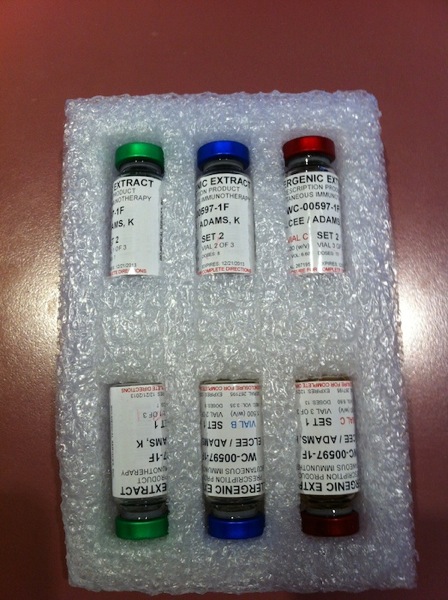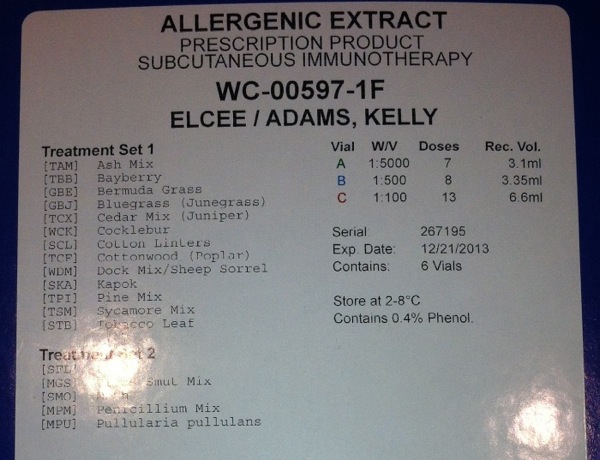Today we started on the first dose of immunotherapy injections for our cat, Elcee. She’s had problems with strange acne-like skin eruptions on her face and chin for years, but the last three years (Elcee is ten years old) they’ve gotten progressively worse.
During her last episode, the rash got into her ears and around her neck and shoulders: she licked her hair completely off in those areas, and ended up with secondary (bacterial) skin and ear infections. It took weeks of treatment to get that cleared up, and the vet advised that we consider allergy tests. As it turns out, Elcee is allergic to a lot of things…
The list of items Elcee is allergic to includes:
- Ash, bayberry, **cedar, cottonwood, pine, and *sycamore (trees)
- Bermuda, *bluegrass, and *timothy (grasses)
- Cocklebur, *dock/sheep sorrel (weeds)
- Grass smut (molds)
- *Cotton, **kapok, mouse, *pyrethrum, and *tobacco (indoor materials)
- Wasps and moths (insects)
The asterisks indicate a higher positive result; double asterisks indicate really high positives. So, our cat is allergic to mice. I suppose it is a good thing that she’s never met one. However, I’m sure she’s encountered some of their allergens. The worst on the list is cedar, which I suspect may be the killer for her: we have two large cedars in the back yard. They drop their leafy bits each fall, which very roughly corresponds to when Elcee seems to have her worst reactions. To make matters worse, our Abyssinians seem intent on bringing pieces of the tree into the house to bat around and play with.
How do you “Fix” cat allergies?
So what does one do with an allergic cat? I suppose if the problem stayed mild, we’d just continue to treat it symptomatically. That is, when it flared up we’d just treat it as we have, with some skin creams and possibly antibiotics for the secondary infections. But Elcee has gotten worse each year for the past few, and this year was particularly uncomfortable. And expensive: I think we spent six or seven hundred dollars on vet visits and treatment for her. Since she is an otherwise pretty healthy and happy cat, I’d like to see if we can make things better.
There are no “cures” for allergies, unfortunately. They wax and wane, and for some lucky souls seem to disappear entirely. But medicine has never been able to cause permanent cures on anything like a reliable basis. The best course has always been one of “desensitization”, or immunotherapy. In essence, you get exposed to that which you are allergic to, gradually, in a controlled way. Over time, your body gets “used” to the allergen and, if everything goes well, starts to ignore it.
This year we have decided to go with the immunotherapy approach. The most effective way to proceed is via injections, so that’s what we are doing. Since they are frequent we are doing them at home.
Shooting the cat
Once the testing is done, a customized course of injections is prepared by the treatment company. For Elcee, this is a series of three “levels” or concentrations of allergen. Since Elcee has some “incompatible” allergens, she gets a bonus: each level consists of two different shots containing different groups of material. The kit for Elcee looks like this:
And here is the “guide” from the package describing what each vial contains and in what concentration:
The injections are done with insulin needles. I’ve given cats insulin shots before: the good thing is that the injections aren’t into a vein, which I couldn’t do (finding a vein is a skill I don’t have), and the needles themselves are extremely fine. If I do things right, the cat will hardly notice the pointy thing piercing their skin. The downside is that this involves needles, which means that Irene can’t help as much as she usually does: she’s a vasovagal needle phobic i.e.: her blood pressure drops precipitously when she sees sharps.
The injections themselves also scale up in volume and down in frequency. So in Elcee’s case, we start at 0.1 CC of both allergen injections every three to four days. Over about 150 days, that changes to a pair of 0.85 CC injections every three weeks. And at that point, we are on a maintenance dose: probably for as long as Elcee continues enjoying the sun, drooling on my shoulder, and barfing up hairballs.
Costs and observations
The cost for the testing was about $350, and the first run of drugs to build up immunity over approximately 150 days was about $400. After that, assuming all goes well, Elcee should no longer be having severe allergic reactions, and the maintenance dose should drop in cost to around $150 per year or thereabouts. If it works, then it is more than worth it: Elcee will be more comfortable, which makes Irene and I happy, and cost-wise this is cheaper annually than treating the reactions symptomatically has been.
Our first round of shots today was a bit rough. Firstly, Irene was a bit too close to the action and nearly fainted. This was complicated by the fact that she was holding Elcee at the time, and Elcee panicked a bit. As a result, I only got about 75% of the second 0.1 CC injection into her. However, the good news is that Elcee didn’t show any obvious reaction to the shot itself.
This is where things get dicey: the reactions. Basically, you are purposefully exposing the cat to something you know they are allergic to. In theory, you are doing so in a very controlled way, gradually increasing the exposure over time as they get used to it. However, allergies are unpredictable: something that only caused a rash one day (an acceptable reaction) might cause anaphylactic shock (a death-dealing emergency) the next.
We have to watch Elcee for abnormal swellings, problems breathing, nausea, etc after each shot. Once we have been doing this for a month or two, we should have a pretty good idea that she is tolerating the process well. But the first month is kind of scary.
Hopefully this whole process works out really well. I’d like to have the process down so that Elcee is relaxed, I’m confident, and Irene doesn’t faint. And I’d love to have Elcee make it through a year without having swaths of her skin raw, fur licked clean off out of irritation and discomfort caused by something in the air that we can’t even see. Time will tell: I’ll report back here as things progress, probably in a couple of months.




Good luck, guys and Elsie! Heck, the shots sure worked for me! :-)!
Thanks, Janet! So far, Elcee seems to be doing fine. We are a bit over half-way through the “blue” (1:500) mix. Elcee has maintained moderate reactions (e.g.: some of the neck/face acne she’s had for years, but none of the really bad breakouts on her skin that she had last fall). She hasn’t had any abnormal reactions like breathing problems or the like, and she’s eating/drinking/etc normally.
And we’ve reached a good accommodation regarding the shots themselves. I sit on the floor with her for a while before and after in a small room, cuddle her to get her purring, poke and pinch the planned area for the shots… and then do the jab. Irene stands by for moral support- mainly for me, so I have someone to make sure I’m doing things as well as I can. Most of the time Elcee hardly notices, although when the volumes get “large” (e.g.: .85 cc) it starts to bother her because of how long it takes to complete the injection. The worst part (for me) is trying to see whether I’ve hit a blood vessel through all of that fur!